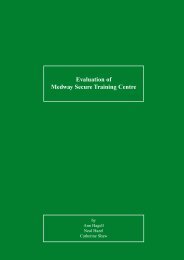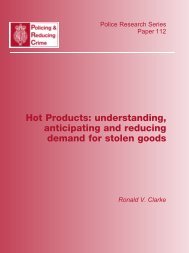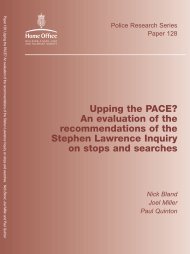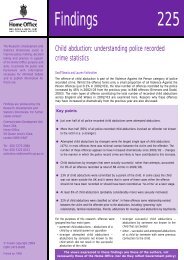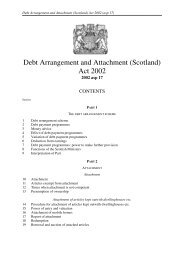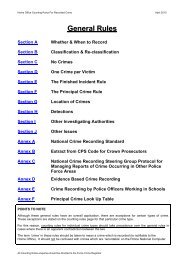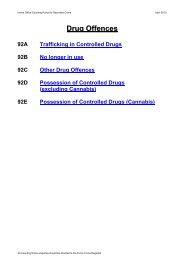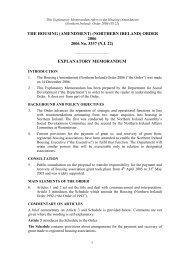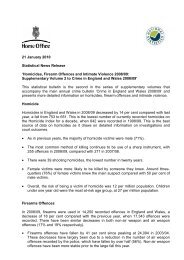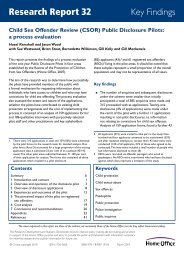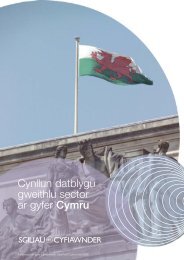Recorded crime counting rules introduction 2010 - nationalarchives ...
Recorded crime counting rules introduction 2010 - nationalarchives ...
Recorded crime counting rules introduction 2010 - nationalarchives ...
Create successful ePaper yourself
Turn your PDF publications into a flip-book with our unique Google optimized e-Paper software.
Home Office Counting Rules For <strong>Recorded</strong> Crime April <strong>2010</strong><br />
Introduction<br />
Background<br />
This document contains the revised set of Rules for <strong>counting</strong> and classifying <strong>crime</strong> as at 1 April <strong>2010</strong>.<br />
The Counting Rules for <strong>Recorded</strong> Crime includes a full copy of the National Crime Recording Standard<br />
(NCRS) at Annex A of the General Rules section. The NCRS was instigated by research from Association of<br />
Chief Police Officers (ACPO), the Home Office (Review of Police Forces’ Crime Recording Practices,<br />
Burrows et al, HORS 204, 2000) and Her Majesty’s Inspectorate of Constabulary (On the Record, HMIC<br />
2000) that revealed a lack of consistency in recording practices across police forces. This was particularly<br />
marked in the proportion of incidents that were recorded as <strong>crime</strong>s.<br />
The NCRS was introduced nationally on 1 April 2002 with the aim of promoting greater consistency between<br />
police forces in the recording of <strong>crime</strong> and to take a more victim oriented approach to <strong>crime</strong> recording. Following<br />
the <strong>introduction</strong> of the NCRS, the National Crime Recording Steering Group (NCRSG) has met regularly to<br />
review the Counting Rules. The Steering Group includes members of the Research Development and Statistics<br />
Directorate (RDS), Force Crime Registrars and Statistics Officers, and representatives of ACPO and Her<br />
Majesty’s Inspectorate of Constabulary (HMIC). The Counting Rules are updated annually to reflect decisions<br />
taken by the NCRSG, changes in legislation and changes to improve clarity and ensure consistency in recording<br />
by police forces.<br />
This set of Rules can be found on the main Home Office website: www.homeoffice.gov.uk/rds/count<strong>rules</strong>.html<br />
or on the dedicated website for Force Crime Registrars (FCRs).<br />
Amendments to the Counting Rules<br />
Dated amendment sheets will continue to be issued on an annual basis. Any updates made to the Counting<br />
Rules during the year will be published online at www.<strong>counting</strong><strong>rules</strong>.homeoffice.gov.uk.<br />
Specific Counting Rule Enquiries<br />
Counting rule enquiries should be directed to the FCR in the first instance. If necessary, the FCR will<br />
forward enquiries to the dedicated Counting Rules e-mail box: <strong>counting</strong><strong>rules</strong>@homeoffice.gsi.gov.uk<br />
Counting Rule enquiries will not be answered over the telephone.<br />
All Counting Rules enquiries should be directed to the Force Crime Registrar
Home Office Counting Rules For <strong>Recorded</strong> Crime April <strong>2010</strong><br />
Guide to using the Counting Rules<br />
In addition to the revisions to the Counting Rules, the overall layout has been updated for ease of reference.<br />
The General Rules have an overall application, however, there are exceptions for certain types of <strong>crime</strong>.<br />
These exceptions are stated on the <strong>counting</strong> <strong>rules</strong> page for that particular <strong>crime</strong> type.<br />
For each <strong>crime</strong> type there are two main instruction pages: the classification page and the <strong>counting</strong> <strong>rules</strong><br />
page. One major layout change relates to the positioning of these pages: the complete set of classification<br />
pages for a particular <strong>crime</strong> type has been presented first followed by the complete set of <strong>counting</strong> <strong>rules</strong><br />
pages for that <strong>crime</strong> type. An example of the revised layout for these pages can be found on the entitled<br />
page Layout of Classification and Counting Rules Pages.<br />
At the end of each <strong>crime</strong> group chapter, there is a maximum sentence table. This should be used, in<br />
conjunction with the principal <strong>crime</strong> look-up table at Annex F of the General Rules, to determine the principal<br />
<strong>crime</strong> when this general rule is applied (see General Rules Section F). For each Home Office subclassification<br />
(eg 8/6), the maximum sentence for that <strong>crime</strong> type is tabulated. This provides guidance in<br />
determining the principal <strong>crime</strong>. The principal <strong>crime</strong> is not always determined by maximum sentence, and<br />
the look-up table illustrates these exceptions, particularly where violent <strong>crime</strong>s take precedence over<br />
property <strong>crime</strong>s.<br />
Definition of terms used in the Counting Rules<br />
The following terms as used in the Rules have the meaning assigned to them as shown:<br />
The Accused<br />
Defendant<br />
Offender<br />
Suspect<br />
Recordable offences<br />
<strong>Recorded</strong> offences<br />
FCR<br />
S<br />
S/V<br />
V<br />
Indictable offences<br />
Triable-either-way offences<br />
The person or persons charged with a <strong>crime</strong>.<br />
A person against whom court proceedings are brought.<br />
One who has committed a <strong>crime</strong>.<br />
A person believed by the authorities to be responsible for a <strong>crime</strong>.<br />
Most criminal offences are recordable (ie recordable on the Police National<br />
Computer)<br />
Criminal offences which are notifiable to the Home Office (ie submitted by<br />
forces via monthly CrimSec3 returns)<br />
Force Crime Registrar<br />
State based offence<br />
State and victim based offence<br />
Victim based offence<br />
All serious offences that must be tried at Crown Court<br />
Offences that are triable either at Crown Court or at Magistrates Court<br />
All Counting Rules enquiries should be directed to the Force Crime Registrar



